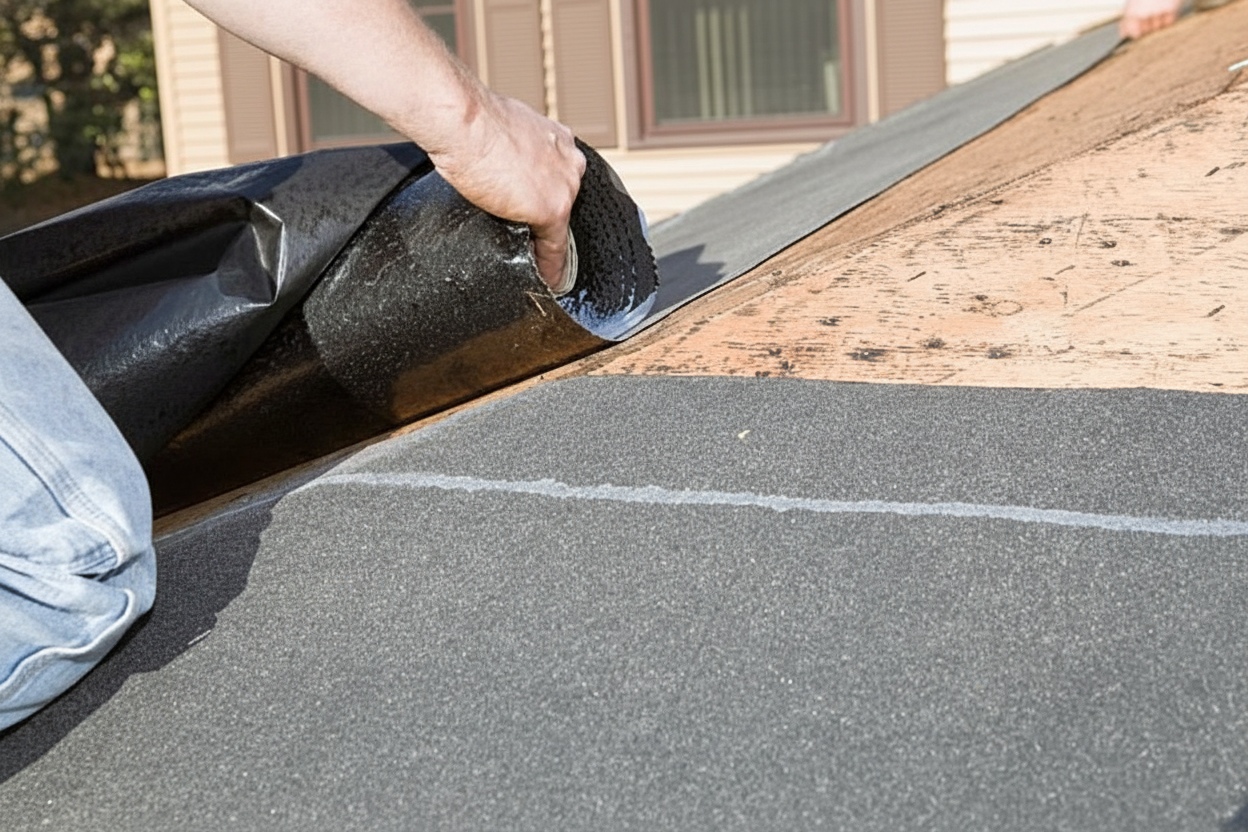How to Choose the Best Roof Underlayment in 2025: 7 Key Factors
Uncategorized
November 22,2025
How to Choose the Best Roof Underlayment in 2025: 7 Key Factors

Alt text: Professional roofer installing synthetic underlayment on residential roof
When you think about your roof, shingles probably come to mind first. But there’s a hidden layer working hard beneath those shingles that deserves your attention. Roof underlayment acts as your home’s waterproof shield, protecting against leaks, moisture damage, and temperature extremes. Choosing the right underlayment can extend your roof’s lifespan and save you from costly repairs down the road.
[!NOTE]
Smart underlayment selection can add years to your roof’s life and prevent thousands in water damage repairs.
This guide walks you through everything you need to know about selecting roof underlayment for your home. We’ll cover the main types available, compare their strengths and weaknesses, and give you seven practical factors to consider before making your choice. Understanding how long different roofing materials last starts with knowing what protects them from underneath.
Understanding roof underlayment types
Three main underlayment types dominate the market today, each with distinct characteristics that suit different needs and budgets.
Asphalt-saturated felt (traditional felt paper)
Felt paper has been the go-to choice for decades. Made from cellulose, polyester, or bitumen-soaked paper, it offers reliable basic protection at an affordable price point.
Advantages:
– Budget-friendly option for cost-conscious projects
– Provides solid moisture barrier protection
– Available in multiple weights for varied durability
Drawbacks:
– Tears easily during installation
– Limited UV and extreme weather resistance
– Shorter lifespan compared to modern alternatives
Synthetic underlayment
Engineered from polyethylene or polypropylene, synthetic underlayment represents modern roofing technology. It’s quickly becoming the preferred choice for homeowners and contractors alike.
Advantages:
– Lightweight and simple to install
– Resistant to tears and wrinkles
– Excellent moisture protection
– UV resistant for extended outdoor exposure
Drawbacks:
– Higher upfront cost than felt paper
– May limit breathability in some applications
[!TIP]
Synthetic underlayment costs more initially but often pays for itself through easier installation and longer lifespan.
Rubberized asphalt underlayment
This premium option combines asphalt with rubber polymers, delivering maximum durability and weather protection for demanding climates.
Advantages:
– Exceptional tear resistance
– Superior waterproofing capabilities
– UV resistant for long-term protection
– Ideal for extreme weather conditions
Drawbacks:
– Highest price point among underlayment options
7 factors for selecting your roof underlayment
Making the right choice requires evaluating your specific situation. Here are seven essential factors to guide your decision.
1. Local climate conditions
Your weather patterns should drive your underlayment choice. Heavy rainfall demands excellent water resistance, while hot climates need UV protection. Cold regions with ice dam risks may benefit from rubberized options. Consider protecting your roof during storm season as part of your overall moisture management strategy.
2. Roofing material compatibility
Some roofing materials work better with specific underlayment types. Metal roofing often requires specialized underlayment to prevent condensation issues. When comparing different roofing material options, factor in compatible underlayment requirements.
3. Project budget
Set a realistic budget that includes both material and installation costs. While premium underlayment costs more upfront, it may reduce long-term maintenance expenses and extend your roof’s service life.
4. Expected durability
Match your underlayment’s lifespan to your long-term roofing goals. If you plan to stay in your home for decades, investing in durable synthetic or rubberized options makes sense. Understanding your roof’s current age helps you plan replacement timing.
5. Installation requirements
Some underlayment types install more easily than others. Synthetic options are lighter and more forgiving for DIY projects, while rubberized products may require professional expertise. Factor in labor costs when comparing options.

Alt text: Homeowner consulting with roofing professional about underlayment selection
6. Attic ventilation needs
Proper ventilation prevents moisture buildup in your attic space. Some underlayment materials allow better airflow than others. If you’ve experienced attic rain or condensation issues, choose breathable underlayment that supports healthy air circulation.
7. Fire safety ratings
[!WARNING]
In wildfire-prone areas, check that your underlayment meets local fire safety codes. Many synthetic and rubberized options offer improved fire resistance compared to traditional felt paper.
Comparing underlayment options side by side
| Feature | Felt Paper | Synthetic | Rubberized |
|---|---|---|---|
| Cost | Low | Medium | High |
| Durability | Good | Better | Best |
| Installation | Moderate | Easy | Moderate |
| Weather Resistance | Basic | Strong | Excellent |
Why synthetic underlayment leads the market
Synthetic underlayment has gained significant market share for good reasons. Its lightweight design reduces installation time and labor costs. The material’s tear resistance means fewer mistakes during installation and better protection once complete. UV resistance allows it to remain exposed longer during multi-day installations without degrading.
Many contractors prefer synthetic options because they perform well across various climate conditions. While the initial price point sits higher than felt paper, the combination of easier installation, longer lifespan, and superior protection often delivers better overall value. When filing a roof insurance claim, having quality underlayment documentation can support your case.
